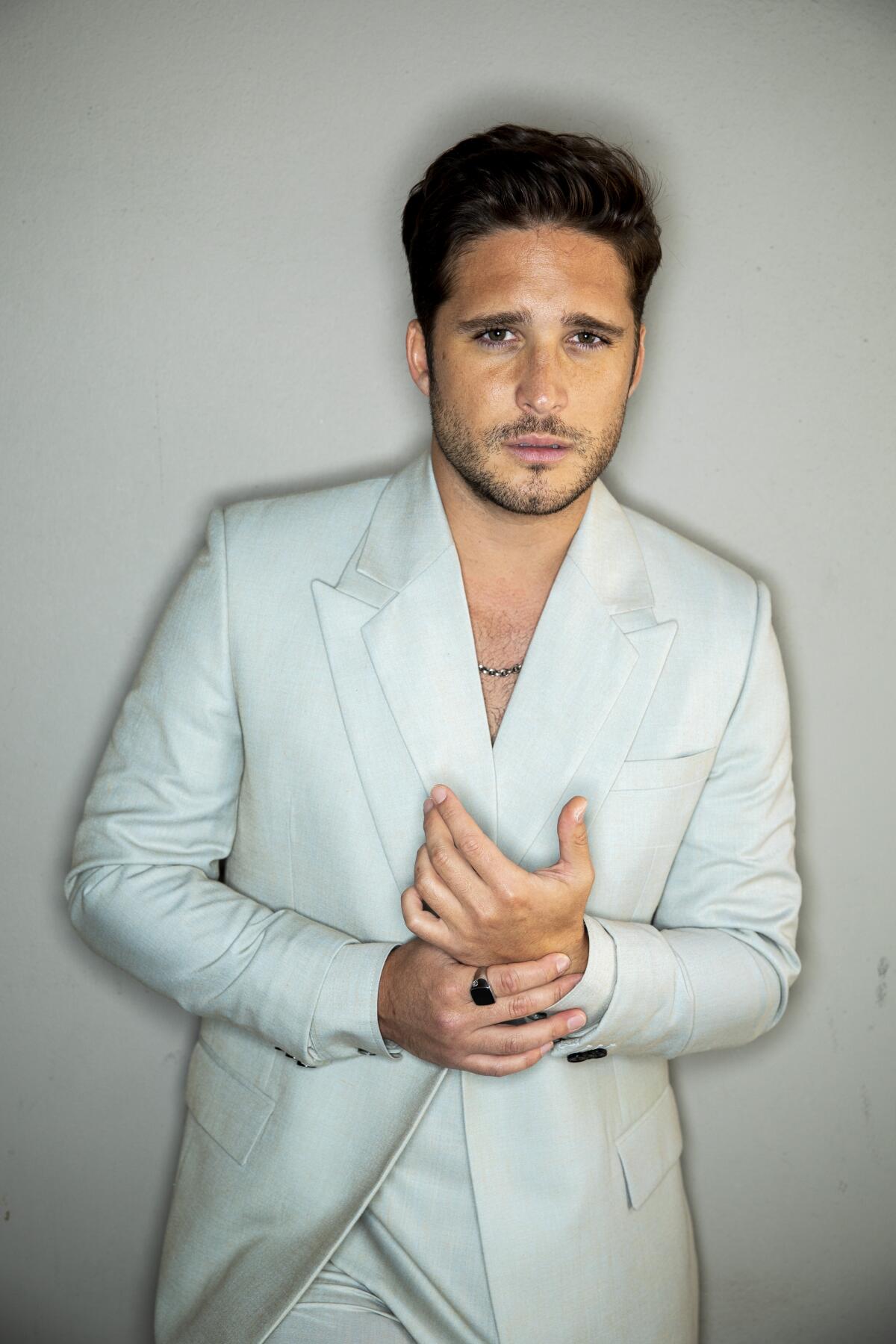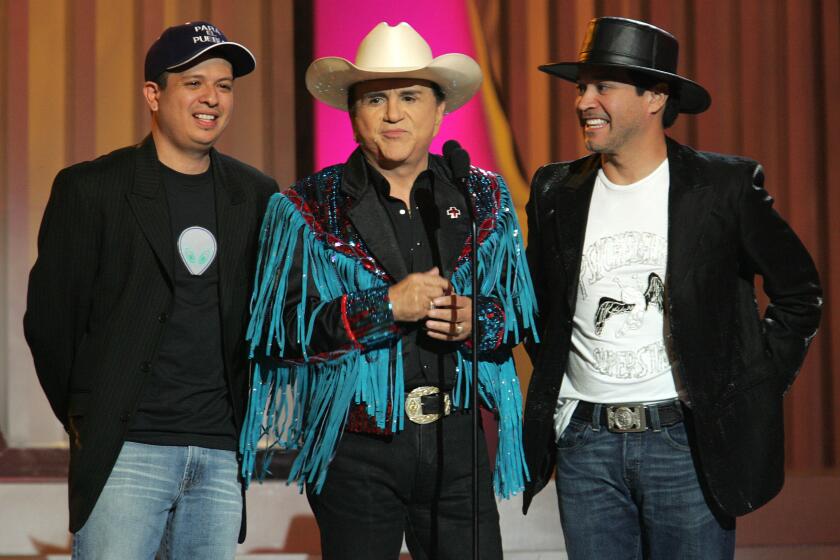How do you play a notoriously guarded musician? Agree to take his secrets to the grave

- Share via
The first time Mexican star Diego Boneta performed live on television, in 2003, he was 12 and a participant in the talent show “Código F.A.M.A.,” an “American Idol”-style competition for kids in his home country.
“La Chica del Bikini Azul,” a lively pop track by internationally renowned singer Luis Miguel, whose full name is Luis Miguel Gallego Basteri, was the song the production assigned Boneta for his debut.
It was a good omen: Fifteen years later, in a career-redefining stroke of fate, Boneta transformed into the singer, often dubbed “El Sol de Mexico” (the Sun of Mexico), for Netflix’s “Luis Miguel: The Series,” which entranced audiences across the Spanish-speaking world and beyond when it premiered in 2018.
When Boneta, now 30, tries describing Luis Miguel, 51, to his non-Latino friends, he refers to the musician as “Elvis Presley meets Frank Sinatra,” which suggests both his vocal aptitude and his larger-than-life persona.
‘Please don’t think I think I’m her,’ Christian Serratos says of her headlining role in the Netflix series about Tejano icon Selena. ‘I know I’m not her.’
One of Latin America’s most successful acts ever, Luis Miguel — and his cross-genre romantic anthems — have filled countless concert venues and sold millions of albums over a nearly four-decade career. He even has a star on Hollywood’s Walk of Fame.
Luis Miguel’s personal life, however, has been marked by tragedy, most notably the unsolved disappearance of his mother in 1986 and a troubled relationship with his father. Part of the appeal of the fictionalized drama, whose second season is now streaming, is that it serves as a window into the private pains of a tight-lipped artist.
“This is the most challenging project I’ve ever done, because it was demanding on every angle: acting, singing and producing,” Boneta said. The series, filmed primarily in Mexico, was the actor’s first foray as executive producer, a behind-the-scenes role he reprised for the topical Mexican film “New Order” (in select theaters Friday from Neon), in which he also stars.
Although Boneta never expected that a show in Spanish about a Latino household name would open more doors in Hollywood than his parts in prominent English-language vehicles “Rock of Ages,” “Scream Queens” and “Terminator: Dark Fate,” he now understands that the global entertainment landscape — and the hurdles within it — are changing.
“I think that tells you two things: that people want to watch the best stories regardless of what language they are being told in and the importance of the Latino market,” he said.
For Boneta, who released solo albums in 2005 and 2008 before shifting his focus to acting, Luis Miguel has always been a major factor in his relationship with music: He was exposed to the superstar’s bright pop era in the ’90s by his parents, and the musician was among the first Boneta ever saw live. Luis Miguel is also the artist Boneta has seen most often in concert. (He estimates it’s close to a dozen times.)
Boneta came to “Luis Miguel: The Series” before there were any scripts or a director on board. Without a line to follow, the actor immersed himself in the singer’s world. “I didn’t know what we were going to be telling, so I spent about a year preparing, first just looking at videos of his live performances and interviews,” he said.
Using platforms like Netflix, YouTube and Spotify, performers such as Franco Escamilla are taking Mexico’s thriving stand-up comedy scene global.
Boneta eventually took part in script development alongside Daniel Krauze, the head writer, and later with director Humberto Hinojosa. The same core group, including producer Pablo Cruz and showrunner Carla González Vargas from MGM’s Gato Grande Productions, is behind both seasons of the series, on which Luis Miguel himself is also credited as an executive producer. Their guiding principle was to keep the show’s tone grounded, to prevent it from veering into the realm of caricature or soap opera.
As part of his extensive preparation, Boneta traveled to Spain to work with acting coach Juan Carlos Corazza, whose clients also include Javier Bardem and Penélope Cruz. For vocal training, he turned to Ron Anderson, whom he knew from “Rock of Ages.”
Absorbing Luis Miguel’s essence became Boneta’s sole purpose, spurred by the knowledge that interpreting someone who is still alive, still relevant and still performing — especially someone so beloved — was a huge risk. “It’s very easy to go on YouTube and verify if he really spoke that way or not, or if he really had those ticks and mannerisms,” he said.

Approaching the portrayal with extraordinary attention to detail, Anderson worked with Boneta to change his singing style, his vibrato, his pronunciation of vowels, his cadence and his timing to resemble that of Luis Miguel as closely as possible.
“He was like, ‘Diego, I’ve never done this before. I’ve never had to teach a singer to sound like another singer,’” Boneta said. “It was a huge challenge, because Luis Miguel’s voice is considered to be one of the best voices of all time.” (Sinatra agreed: He invited Luis Miguel to duet on “Come Fly With Me” on his 1994 album, “Duets II.”)
Separated by a three-year gap, the action of Seasons 1 and 2 covers discrete periods of Luis Miguel’s career. The first season is based on Javier León Herrera’s “Luis Mi Rey,” which chronicles Luis Miguel’s life up to the death of his father in 1992. The second, covering the ’90s and early 2000s, required going back to the singer and people who knew him at the time to piece together the story.
Over the long pre-production process, Boneta met with Luis Miguel four times. They spent several hours getting to know each other, and a unique trust formed.
The latest prize-winning feature from the Mexican writer-director Michel Franco (‘Chronic’) is the emptiest of provocations.
“He shared some things that he asked me to not share with anyone else, not even the writers,” Boneta said. “‘This is just for you Diego, to help you.’ We shared that secret. It created a complicity between us, and I’m going to take the things he told me to the grave.”
Boneta’s favorite films based on the lives of celebrated musicians are “Ray” and “Walk the Line,” since their narrative arcs follow the rise, fall and resurgence of their protagonists, and each stars a highly committed actor: Jamie Foxx as Ray Charles and Joaquin Phoenix as Johnny Cash, respectively.
“When I spoke to Jamie Foxx, I said, ‘Dude, what advice can you give me?’ He knew exactly who Luis Miguel was. He said, ‘It’s very simple. Do everything. If there’s a picture in a scene with him and his brother, it has to be you. Let there be no reference of the real Luis Miguel on the show. Re-create everything, from an album cover to a picture in the set decoration to singing the songs. By the way, good luck singing the songs, because that guy has pipes.’”
Indeed, one of the hardest parts of the role was singing in Luis Miguel’s original keys. “He is a musical virtuoso. He has a range, which is pretty much the same range that Freddie Mercury had — he belts at very crazy high notes. We’re talking high Cs in pretty much every one of his songs,” said Boneta. The most difficult track for him was “Ayer,” the lead single from Luis Miguel’s Grammy-winning 1993 album “Aries.”
The series’ not-so-secret weapon was Kiko Cibrian, the music producer behind many of Luis Miguel’s hits, including “Suave.” He reproduced the songs from scratch 20 years later. And Cibrian didn’t work from the original masters. Instead, every instrument was rerecorded for Boneta’s versions.
Ripe with emotion, Season 2 was doubly strenuous for Boneta, who had to play the singer in his 20s and 30s. For scenes as the the older Luis Miguel, Boneta used prosthetics to match the facial structure of the maturing performer.
“The Johnny Canales Show” was a mainstay of Spanish-language TV in America, launching the careers of countless Tejano, conjunto and norteño music stars.
Academy Award-winning makeup artist Bill Corso was in charge of Boneta’s physical metamorphosis. Working with a team of Mexican makeup artists headed by Alfredo “El Tigre” Mora, Corso created the pieces to augment and restructure the actor’s features and the Mexican team then applied them.
Having Luis Miguel’s “face” helped Boneta approach the other visible traits in a more measured manner; he didn’t have to exaggerate his mannerisms, for instance. “Once I knew the timelines that we were going to be exploring this time, I focused on those years of his life like a microscope to really try to become him. It’s not an impersonation. This is becoming the character and putting myself in his shoes,” he said.
Boneta sees Luis Miguel’s life story as a Shakespearean tragedy. Season 2 is a more layered expression of the man he became as a result of trauma. This Luis Miguel is no longer a naive victim of his father’s actions but a man who knows exactly where he stands in the music industry. He recognizes the power he possesses but also how alone he is amid the greed, deceit and conflicting egos.
This task meant embracing the less flattering side of a seemingly untouchable figure. And for Boneta, the elements of his performance — the research, the singing, the physical transformation — are all tools for understanding Luis Miguel’s impulses and motivations.
“It’s the job of an actor to be your character’s attorney,” Boneta said, “and instead of judging him, to justify him.”
‘Luis Miguel - The Series’
Where: Netflix
When: Anytime
Rating: TV-MA (may be unsuitable for children younger than 17, with advisories for coarse language and sexual content)
More to Read
The complete guide to home viewing
Get Screen Gab for everything about the TV shows and streaming movies everyone’s talking about.
You may occasionally receive promotional content from the Los Angeles Times.








